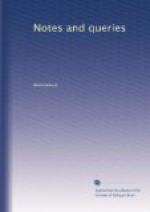A. DE. MORGAN.
* * * * *
Minor Queries
Plurima Gemma.—Who is the author of the couplet which seems to be a version of Gray’s
“Full many a gem of purest ray serene,” &c.?
“Plurima gemma latet caeca tellure
sepulta,
Plurima neglecto fragrat odore rosa.”
S.W.S.
Emmote de Hastings.—
“EMMOTE DE HASTINGS GIST ICI” &C.
A very early slab with the above inscription was found in 1826 on the site of a demolished transept of Bitton Church, Gloucester. By its side was laid an incised slab of —— De Bitton. Both are noticed in the Archaeologia, vols. xxii. and xxxi.
Hitherto, after diligent search, no notice whatever has been discovered of the said person. The supposition is that she was either a Miss De Bitton married to a Hastings, or the widow of a Hastings married secondly to a De Bitton, and therefore buried with that family, in the twelfth or thirteenth century. If any antiquarian digger should discover any mention of the lady, a communication to that effect will be thankfully received by
H.T. ELLACOMBE.
Bitton.
Boozy Grass.—What is the derivation of “boozy grass,” which an outgoing tenant claims for his cattle? Johnson has, “Boose, a stall for a cow or ox (Saxon).”
A.C.
Gradely.—What is the meaning, origin, and usage of this word? I remember once hearing it used in Yorkshire by a man, who, speaking of a neighbour recently dead, said in a tone which implied esteem: “Aye, he was a very gradely fellow.”
A.W.H.
Hats worn by Females.—Were not the hats worn by the females, as represented on the Myddelton Brass, peculiar to Wales? An engraving is given in Pennant’s Tour, 2 vols., where also may be seen the hat worn by Sir John Wynne, about 1500, apparently similar to that on the Bacon Monument, and to that worn by Bankes. A MS. copy of a similar one (made in 1635, and then called “very auntient”) may be seen in the Harleian MS. No. 1971. (Rosindale Pedigree), though apparently not older than Elizabeth’s time. With a coat of arms it was “wrought in backside work”—the meaning of which is doubtful. What is that of the motto, “Oderpi du pariver?”
A.C.
Feltham’s Works, Queries respecting.—
“He that is courtly
or gentle, is among them like a merlin
after Michaelmas in the field
with crows.”—A Brief Character
of the Low Countries,
by Owen Feltham. Folio, London, 1661.




